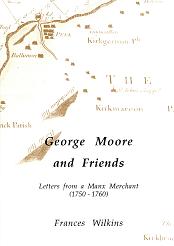Series Information: MANX
The Isle of Man & the Jacobite Network
Its location in the middle of the Irish Sea ensured that the Isle of Man would be affected by the events in surrounding countries. It is not surprising therefore that Jacobites should be found there, either 'lurking' from justice or awaiting a call to join the new Stuart government in London. What is surprising, however, is the number of non-political connections - the trading networks that included Jacobites and non-Jacobites. Also surprising is a marked difference between the situation on the Island in 1715, when both 'strangers' and local residents were frequently found drinking 'disaffected healths', and 1745, when the houses of the catholic merchants in Douglas were stoned. This book concentrates on the people involved in these events. The result is a new approach to the well-known story of the Jacobite rebellions.
George Moore and Friends: Letters from a Manx Merchant (1750-1760)
This book is based on the letters written by George Moore, a Manx merchant, between 1750 and 1760. Addressed to merchants in Europe, the West Indies and Boston in America; to customers for 'smuggled' goods along the west coast of Scotland from Fort William in the north to Kirkcudbright in the south and to his family, these letters provide a detailed insight into the 'other side' of the smuggling story. At the same time it is possible to identify several of Moore's correspondents in the local custom house letter-books and in other contemporary documents.
This book is a gold mine for family historians. Every addressee is listed and every friend named in comprehensive indices. Information not found elsewhere may well be found in this volume. In addition, an insight provided into the niceties of eighteenth century life makes it a valuable reference book for Manx social history. Family Tree Magazine
Frances Wilkins provides maritime and business historians with a very good micro-study of a British merchant active during the mid-eighteenth century. Her close and exhaustive reading of the merchant's outgoing correspondence yields details that put meat on the dusty bones of port books and customs records, and gives is a rare glimpse into the commercial mentality of an earlier era. Works like this - narrowly focussed, based directly on archival sources, and attentive to detail - are the building blocks necessary for wider, comparative understanding of trade and shipping during the ancien regime ... the book is handsomely produced, with period maps and portraits. Wilkins apparently set up the Wyre Forest Press to publish books on smuggling history; the study of Moore appears to be the fifth in the series. We hope Wilkins continues to mine what seem to be rich archival sources on the Isle of Man and Scotland for further studies. Maritime historians will welcome further publications from Wyre Forest Press. The Northern Mariner
The Isle of Man in Smuggling History
1992
ISBN 978 1 897725 00 9
A5 144pp paperback
Out of Print
2,000 Manx Mariners
This book describes the lifestyles of Manx mariners during the eighteenth century: the local boatmen, herring fishermen, wherrymen, coastal traders, overseas traders and Guinea traders. There were several small boats trading from port to port round the Island - these are named in the customs ingates and outgates, which emphasise the relative importance of Cranstal, Bride and Ramsey in the first quarter of the century. Larger dedicated trading vessels, such as the Rose of Douglas, plied regularly between the Island and England, Ireland and Wales. The fees paid for anchoring a fishing boat (the 'Herring Customs') were recorded each year. As a result it is possible to reconstruct the herring 'fleets' associated with the different parishes on the Island. The running trade depended on boats to take goods from the Isle of Man to England, Scotland, Ireland or Wales. Further afield, Manx mariners were on board vessels trading with Europe, the West Indies and America, and, from time to time, the East Indies. Manx captains commanded at least 25% of the Guinea vessels sailing from Liverpool towards the end of the slave trade. Their careers are of interest but also are those of the common seamen on board these vessels. One of the main hazards facing these crews was impressment into the Navy. Names of some Manxmen who died in the Navy are listed.
ISBN 978 1 897725 14 6
A4 144pp paperback
Out of Print
2,000 & more Manx Mariners
This is a new, extended and fully illustrated version of 2,000 Manx Mariners now out of print for nearly 15 years.
2016
ISBN: 978-1-897725-32-0
A4 200pp ringbound
Out of Print
The Smuggling Trade Revisited
Smuggling dominated the lives of everyone living on the Irish Sea coasts during the eighteenth century - the merchants who provided the low-priced tea, rum, brandy, wine and tobacco, the seamen who brought these goods from Europe and America, the coopers who made the small casks that could be handled more easily than large barrels and chests, the wherrymen who delivered these casks to the coast, the smugglers who transported them inland and the revenue officers who attempted to stem the flow of contraband goods to the customers. This book draws on seven years of research into contemporary eighteenth century sources to produce a vivid story of that smuggling trade.
2004
ISBN 978 1 897725 12 2
A4 320pp hardback
Out of Print
The Life and Times of John Bignall Merchant of Dublin, Douglas and Ramsey
This book was inspired by the detailed information attached to John Bignall's will. Material describing his life was found in Northern Ireland and in public and private archives in Scotland.
ReviewThis is a worthwhile addition to a Manx historian's library. Isle of Man Natural History and Antiquarian Society
2011
ISBN 978-1-897725-16-0
A4 128pp ringbound
Out of Print
Manx Slave Traders
This is the story of the Manx people who participated in the eighteenth century slave trade as merchants, shipowners, captains, officers, surgeons and ordinary sailors. Manx merchants warehoused East Indian textiles, beads, gunpowder, brass pans and other goods which were collected by vessels from the mainland on their journey to the west coast of Africa. Manx mariners were on board the slaving vessels. A particular feature of the book is that it is based almost entirely on documents written at the time. Very extensive Manx records still survive on the Island so that a wide range of relevant material was available. This was supplemented from references to Manx activities in maritime archives elsewhere. Appendices list Atlantic slave trade events which involved Manx people, Manx ownership of slaving vessels and Manx mariners who died on the Guinea coast of Africa.
1999
ISBN 978 1 897725 13 9
A4 144pp hardback
Out of Print

